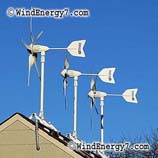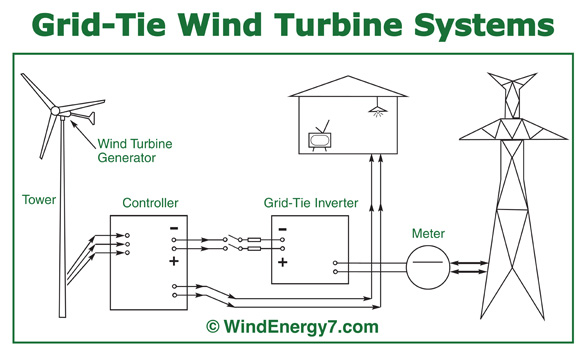Texas Energy Policy, Inhibiting Green Energy!
Wednesday, December 31st, 2008Related Article: Michigan Energy Policy, Needs Change In Leadership?
Real Quick, What is net metering?
“Net Metering” is the most critical public policy and state regulated rules that govern YOUR PERSONAL ENERGY RIGHTS, FREEDOM. Through Net Metering, energy consumed and produced at a home or business that has a home wind turbine or solar system is metered and credited. Under net metering, excess electricity produced by the wind turbine will spin the existing home or business electricity meter backwards, effectively banking the electricity until it is needed by the customer. This provides the customer with full retail value for all the electricity produced.
If you can’t afford a windmill or solar system for your home, we still need you to get involved, right here. This article will point out how your state, Texas has serious limits on your personal energy rights. That’s right, people in states like Colorado, New Jersey, etc. have far more rights and freedom for personal energy than you. Please make these same points to your elected officials, Governor, State Representatives, Local newspapers, and Utility Commissions. Join me in calling on US Congress and US Senate to legislate a standardized Net Metering Policy, nationally. We need National Standards for Net Metering Policy to support wind and solar progress, not stifle it. Having these states all do their own thing is limiting many Americans from their personal energy rights. But first, for now, we need to shine the light on these state policies and get reforms in our own back yard.
Here’s a quick look at Texas Net Metering Rules. I’m going to compare them to other states, states where the government Utility Commissions and Politicians are on the side of taxpayers and not sold out to Fat Cat Utility companies. If the Texas taxpayers don’t understand what needs to happen, and make noise to public officials, then the Utility Companies are the ones most influencing policy, not the consumers. Thus we will be stuck with these limits on green energy for homeowners and businesses.
I’ll use Colorado and New Jersey in some real basic policy comparisons so you can easily see where you, in Texas, are getting hosed by Big Utility friendly policy.
Texas Limit on System Size: 100 kW for qualifying facilities; 50 kW for renewables (see summary)
OK, that is enough for most but not all residences, depending on wind resources. Any very large residence, normal business, or a consumer in a lower wind area could need more power than that. What does that mean? Well, it means that by your states Utility Commission rules, they and their big Utilities they are supposed to “regulate” have it fixed on the taxpayer. As a taxpayer, many larger residences and most businesses will have to go Off-Grid to generate ALL their own power. Not good enough. No freedom in that, no justice. WHO is most likely to afford to invest in green energy? The largest residences and some stable businesses that can afford it… Doh. Sorry, your elected officials and their corrupt Utility “Regulators” have basicall put a limit in there for that…
Compare To, New Jersey Limit on System Size: 2MW, 2,000,000 watts
OK, meaning a person in New Jersey has dramatically more rights to personal energy than a taxpayer in Texas. That’s enough to power 2 WalMart stores! To be mathematic, a New Jersey taxpayer has 20 times the personal energy rights than a taxpayer in Texas. That sucks for Texas taxpayers, but maybe not so bad for the Big Utilities and the government “regulators” and politicians that support these limits on taxpayer rights to personal energy. They keep that ceiling over your head to hold back green energy, or keep it for themselves. We all have wind, sun, we should all have freedom to make OUR OWN electricity from it.
Texas Limit on Overall Enrollment: None
OK, this is great, same as leading states like Colorado. In many states like Michigan, the fat cats have it capped at 0.5% of grid capacity, then they don’t have to allow anyone else… It’s too successful at 0.5% and they want it stopped.. Nice.
Texas Treatment of Net Excess: Purchased by utility for a given billing period at avoided-cost rate.
OK, that’s a rip off. That means they can pay you whatever their idea is of their “avoided cost”. Bogus. And they can take your excess, pay you a fraction for your power generated, sell it to your neighbors an retail rate. Your Texas Net Metering Policy is getting an “F” for this bad policy. This should specifically be a 1 to 1 retail rate, what they charge is what they credit/pay otherwise they are taking advantage.
Colorado, Treatment of Net Excess: Credited to customer’s next bill; IOUs: utility pays customer at end of calendar year for excess kWh credits at the average hourly incremental cost for that year. Co-ops and Munis: annual reconciliation at a rate deemed appropriate by the utility. The annual period is undefined.
Texas Utilities Involved: Applies only to all integrated IOUs that have not unbundled in accordance with Public Utility Regulatory Act § 39.05; does not apply to municipal utilities, river authorities and electric cooperatives
Oh Boy, In Texas, some of the highest cost power is in munis, co-ops, and river authorities. These rules are crafted to allow many over-priced Utility Companies to be outside the rules. That stinks too. We need all inclusive wording here no matter who’s contriuting to who’s campaign, or paying gifts, bribes, whatever goes on there.
Colorado Utilities Involved: All IOUs and co-ops; munis with more than 5,000 customers
OK, Here, Colorado basically doesn’t let anyone out of Net Metering Rules, that’s really good. In Texas, some of the highest cost power is in munis and co-ops. Texas needs to step up to other states level of energy freedom here and “regulate”, stop protecting their buddies.
*HB 3693, passed in May 2007 and effective September 2007, appears to make significant modifications to Texas net metering and interconnection policy. As of April 2008, the Electric Reliability Council of Texas (ERCOT) and the Public Utility Commission of Texas (PUCT) were still in the process of implementing this legislation. Although implementation is ongoing, an April 2008 PUCT order clarifies that net metering will not be available in areas of Texas in which retail electric competition has been introduced. The impact of HB 3693 on net metering availability in non-competitive areas of Texas is still being determined. PUCT documents on this subject are available under Docket 34890 while ERCOT is addressing issues for small renewable generators (<50 kW) through its Profiling Working Group.
As we speak there are loopholes and complication being piled on in favor of Fat Cat Utilities by bureaucrats and politicians beholden to them. This PUCT, ERCOT, and such is a diversion allowing multiple rules in play on your rights… YOUR VOICE IS NEEDED.
Also, forward these links to your local texas papers and write letters to the editor, send to local news for exposure and attention.
Contact: Governor Rick Perry
Office of the Governor
P.O. Box 12428
Austin, Texas 78711-2428
Citizen’s Opinion Hotline: (800) 252-9600
FAX: (512) 463-1849
FAX:(517) 335-6863
http://www.governor.state.tx.us/contact/
http://governor.state.tx.us/about/
Contact:
Public Information – PUCT
Public Utility Commission of Texas
7800 Shoal Creek Boulevard, #400N
Austin, TX 78757
Phone: (512) 936-7000
E-Mail: customer@puc.state.tx.us
Contact: Texas State Representatives:
Leadership in the House is headed by the Speaker of the House, who makes committee appointments and designates which committee(s) each Representative will serve on.
Here you can find a listing all Texas Representatives and their contact information, including office phone numbers and e-mail addresses. If you use this by Zip Code, it will give you your US Senators as well.
Find Texas State Representatives By Zip
For Wind Turbine Sales or Dealer Inquiries turbine@windenergy7.com.
If you are interested in starting a wind project for your residence or acreage, contact us. To Buy a Wind Turbine or Become a Dealer, Please fill out our Contact Form. The system will automatically send you some additional info.







 We get so many calls at WindEnergy7 from folks who want to install a wind system. One of the top things that customers say is, “I want to save on utility bills and and maybe make some money” So, at WindEnergy7 we try to make this happen for our customers. There are several factors to consider and calculate to see what your wind project can do, financially. Local Utility and State Net Metering policy is one factor that you have to find out about and understand.
We get so many calls at WindEnergy7 from folks who want to install a wind system. One of the top things that customers say is, “I want to save on utility bills and and maybe make some money” So, at WindEnergy7 we try to make this happen for our customers. There are several factors to consider and calculate to see what your wind project can do, financially. Local Utility and State Net Metering policy is one factor that you have to find out about and understand.